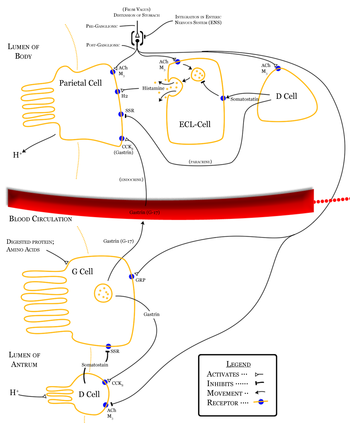Gastric acid
|
|
Gastric acid is, together with several enzymes and the intrinsic factor, one of the main secretions of the stomach. Chemically it is an acid solution consisting mainly of hydrochloric acid, but also containing small quantities of potassium chloride (KCl) and sodium chloride (NaCl).
| Contents |
Physiology
Gastric acid is produced by parietal cells (also known as oxyntic cells) in the stomach. Its secretion is a complex and energetically expensive process. Parietal cells contain an extensive secretory network (called canaliculi) from which the gastric acid is secreted into the lumen of the stomach. These cells are part of epithelial fundic glands in the gastric mucosa. The pH of gastric acid is 2-3 in the stomach lumen, the acidity being maintained by the proton pump, a H+/K+ ATPase. The parietal cell releases bicarbonate into the blood stream in the process, which causes the temporariry rise of pH in the blood, known as alkaline tide.
The resulting highly acidic environment in the stomach lumen causes proteins from food to lose their characteristic folded structure (or denature). This exposes the protein's peptide bonds. The gastric acid also activates pepsinogen into pepsin - this enzyme then helps digestion by breaking the bonds linking amino acids, a process known as proteolysis. . In addition, many bacteria cannot survive in such an acidic environment, preventing bacteria found in foods from infecting the body.
Secretion
The gastric acid secretion happens in several steps. Chloride and hydrogen ions are secreted separately from the cytoplasm of parietal cells and get combined into HCl only in their canaliculi. Gastric acid is then secreted into the lumen of the oxyntic gland and gradually reaches the main stomach lumen.
The highest concentration that it reaches in the stomach is 160 mM in the canaliculi. This is about 3 million times that of arterial blood, but almost exactly isotonic with other bodily fluids. The lowest pH of the secreted acid is about 0.8, but the acid gets diluted in the stomach lumen to the pH between 2 and 3.
At first, negative chloride ions and sodium ions get secreted actively from the cytoplasm of the parietal cell into the lumen of the canaliculus. This creates a negative potential of -40 mV (millivolts)to -70 mV across the membrane that enables the diffusion of potassium ions and a small number of sodium ions from the cytoplasm into the canaliculus.
Another step is the production of hydrogen ions in the cytoplasm of parietal cells. The enzyme carbonic anhydrase catalyses the reaction between carbon dioxide and water, in which carbonic acid is produced. This acid immediately dissociates into hydrogen ions and hydroxyl ions. The hydrogen ions leave the cell by the aid of H+/K+ ATPase antiporter.
At the same time sodium ions are actively reabsorbed. This means the largest amount of secreted K+ and Na+ ions return into the cytoplasm. In the canaliculus, secreted hydrogen and chloride ions combine into HCl and are then secreted into the lumen of the oxyntic gland.
Regulation of secretion
Gastric acid production is regulated by both the autonomic nervous system and several hormones. The parasympathetic nervous system, via the vagus nerve, and the hormone gastrin stimulate the parietal cell to produce gastric acid, both directly acting on parietal cells and indirectly, through the stimulation of the secretion of the hormone histamine from enterochromaffine-like cells (EPC). Vasoactive intestinal peptide, cholecystokinin, and secretin all inhibit production.
The production of gastric acid in the stomach is tightly regulated by positive regulators and negative feedback mechanisms. Four types of cells are involved in this process: parietal cells, G cells, D cells and enterochromaffine-like cells. Besides this, the endings of the vagus nerve (X) and the intramural nervous plecus in the digestive tract influence the secretion significantly.
Nerve endings in the stomach secrete two stimulatory neurotransmitters: acetylcholine and gastrin-releasing peptide. Their action is both direct on parietal cells and mediated through the secretion of gastrin from G cells and histamine from enterochromaffine-like cells. Gastrin acts on parietal cells directly and indirectly too, by stimulating the release of histamine.
The release of histamine is the most important positive regulation mechanism of the secretion of gastric acid in the stomach. Its release is stimulated by gastrin and acetylcholine and inhibited by somatostatin.
Neutralization
In duodenum, gastric acid gets neutralized by sodium bicarbonate. This also blocks gastric enzymes that have their optima in the acid range of pH. The secretion of sodium bicarbonate from pancreas is stimulated by gastrin. This polypeptide hormone gets activated and secreted from so-called S cells in the mucosa of the duodenum and jejunum when the pH in duodenum falls below 4,5 to 5,0. The neutralization is described by the equation:
- HCl + NaHCO3 → NaCl + H2CO3
The carbonic acid instantly dissociates into carbon dioxide and water.
Safety mechanisms
There are several safety mechanisms that prevent the damage of gastric epithelium. Nonetheless, when due to different reasons these fail (e.g. because of excess acid production), this can lead to heartburn or peptic ulcers.
Role in disease
In hypochlorhydria and achlorhydria, the parietal cells are unable to produce the required amount of gastric acid in the stomach, potentially leading to gastroenteritis. Also the disinfectant properties of the gastric milieu are decreased, leading to an increased risk of infections of the digestive tract (such as the foodborne infection with Vibrio vulnificus).
In Zollinger-Ellison syndrome and hypercalcemia, there are increased gastrin levels, leading to excess gastric acid production, which can cause ulcers.
In diseases featuring excess vomiting, patients develop hypochloremic metabolic alkalosis (decreased blood acidity by H+ and chlorine depletion).
Pharmacology
The proton pump enzyme is the target of proton pump inhibitors, used to increase gastric pH in diseases which feature excess acid. Antacids neutralize existing acid.

